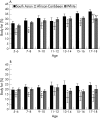Ethnic and gender differences in body fat in British schoolchildren as measured by DXA
- PMID: 17522163
- PMCID: PMC2083240
- DOI: 10.1136/adc.2007.117911
Ethnic and gender differences in body fat in British schoolchildren as measured by DXA
Abstract
Background: There are known to be ethnic differences in body composition in adults which are related to ethnic differences in adult disease.
Objectives: To evaluate gender and ethnic differences in percentage body fat in British schoolchildren and to compare these differences with classification of obesity using body mass index (BMI) criteria.
Design: A cross-sectional study of 1251 healthy children and adolescents aged 5-18 years from white, South Asian and African-Caribbean ethnic groups. Percentage body fat was determined by dual x ray absorptiometry and the subjects classified using BMI criteria for overweight and obesity.
Results: Significant gender differences in percentage body fat were seen, with girls having higher values from the age of 5 years. Girls had 3.8% higher percentage body fat at 5 years of age increasing to 12.9% at 18 years of age. Significant ethnic differences were found, with South Asian girls and boys having the highest percentage body fat from 5 and 7 years of age, respectively. These differences increased with age, being most significant in the teenage years. Although South Asian girls and boys were over-represented in the group containing children with more than 25% body fat (p<0.0001, chi2 test), African-Caribbean subjects were more likely to be classified as obese using BMI criteria.
Conclusions: There are clear gender and ethnic differences in percentage body fat in British schoolchildren which may relate to known differences in the risk of type 2 diabetes in adolescence and adulthood. BMI criteria for defining overweight and obesity do not accurately identify ethnic differences in body fat.
Conflict of interest statement
Competing interests: None.
References
-
- McKeigue P M, Shah B, Marmot M G. Relation of central obesity and insulin resistance with high diabetes prevalence and cardiovascular risk in South Asians. Lancet 1991337382–386. - PubMed
-
- Shelgikar K M, Hockaday T D R, Yajnik C S. Central rather than generalised obesity is related to hyperglycaemia in Asian Indian subjects. Diabet Med 19918712–717. - PubMed
Publication types
MeSH terms
LinkOut - more resources
Full Text Sources
Medical


